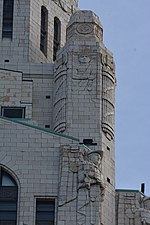LeVeque Tower
Designed by C. Howard Crane, the 353,768-square-foot (32,866.1 m2) Art Deco skyscraper was opened as the American Insurance Union Citadel in 1927 and at the time was the fifth tallest building in the world.
The tower's office space saw mixed success in attracting tenants during its early history, but it became home to a number of state agencies and law firms.
The current owners subsequently converted it into a mixed-use development, including a hotel, apartments, condominiums, offices and a restaurant, which opened in 2017.
[10] Initially, Crane considered stone for the building's exterior but later decided on cream-colored terracotta despite concerns its blocks would be small and prone to warping.
[16] Elevators serving the building were a "micro self-leveling type," automatically controlled by push buttons and which could travel at 900 feet (270 m) per minute, which rose to the 41st floor.
[17] Water tanks for fire protection and plumbing were placed on the 23rd and 43rd floors, and the building was also designed with duplicate mechanical systems for redundancy.
[18] An executive dining room, termed the Mid-Air Club, was built on the 43rd floor, sponsored by local businessmen and aviation enthusiasts.
[21] On January 26, 1925, an accident occurred underground that killed four workers when a toxic gas was accidentally released during the setting of the caissons, overwhelming them and causing them to fall into the foundation.
In the old days of strong fortifications, such cities as Nuremberg, Chester and Quebec were defended, first of all, by a surrounding wall, the foundations of which were protected by a moat.
The name of Citadel is especially appropriate as a watchword of a great insurance company; for millions of families in the United States protect themselves, from the "terror by night and the destruction that wasteth at noonday" through this defensive institution.
Dudley Crafts Watson, director of Chicago Art Institute, highlighted it as one of five great examples of artistic achievement to come out of Columbus in the 1920s, calling it "the most original and American of skyscrapers" and "just an honest piece of magnificent construction.
During the building's 2012-17 restoration, the floodlights were replaced with computer-controlled LED lights to save on energy usage and allow for a wider array of color options.
The building is now lit for events about six to eight times per year, including pink for the Susan G. Komen for the Cure breast cancer organization in April and May; rainbow colors during the Columbus Pride weekend in June; red, white, and blue for the Fourth of July; purple for Purple Heart recognition in August; teal for ovarian cancer awareness in September; and red and green during the Christmas and holiday season.
[28] After the tower's completion, the American Insurance Union occupied floors 19 and 20, with the remainder of the space available for rent to other office users.
[6] The construction of the building saw several significant cost overruns, prompting the American Insurance Union to dip into its monetary reserves to pay for the tower.
[29] Financial problems soon arose for the company, as the tower cost $800,000 more than its budget allowed for, and not all of the office space in the building filled up quickly.
[9] As a number of other major commercial ventures like the Huntington National Bank and American Electric Power flourished in the city, its urban core saw construction of new high-rises to suit them.
[8] It faced increasing competition from other office buildings being constructed in Downtown Columbus in the 1980s, and LeVeque put $18 million into renovations to keep the historic tower competitive with newer and more modern office space, including an entirely new HVAC system, energy efficiency upgrades, and updates to the bathrooms and public areas of the building.
[42] She had previously engaged an architect on a proposal to convert part of the building to residential use, but it was deemed not financially feasible at the time.
[46] The partners planned a $22 million project to fix cracked terracotta on the tower and convert it from an office building to a hotel and residential structure.
[53] In recent years, the building's third floor has held a U.S. Immigration and Customs Enforcement (ICE) office and detention center.
[54][55] The building's two wings were used as an extra 600 rooms for the Deshler Hotel, which had been built at the northwest corner of Broad and High streets.
Called the Deshler-Wallick Hotel by the time the LeVeque tower opened, the 600 rooms were accessible by a "venetian bridge" linking the two buildings on the second floor.
New York Mayor Jimmy Walker, who attended the opening, tried and nearly succeeded in having a ceremonial sip of wine in each of the 600 hotel rooms.
Among them were Bing Crosby, George Burns, Gracie Allen, Gypsy Rose Lee, Jack Benny, Tom Mix, Jackie Gleason, The Three Stooges, Eddie Cantor and Mae West, who performed in March 1938 and broke all its previous attendance records.
[61] It hosted a number of bands in the 1940s, including Duke Ellington, Tommy Dorsey, Glenn Miller, Louis Armstrong, Count Basie, Guy Lombardo, Benny Goodman and Lionel Hampton.
The theatre hosted the world premiere of The Male Animal on March 12, 1942, which was attended by Henry Fonda, Olivia de Havilland, James Thurber and Joan Leslie.
[62] Among these, it brought in Red Skelton, Sammy Davis Jr., Mickey Rooney, Tom Jones, Natalie Cole, Judy Collins and Tony Bennett.





